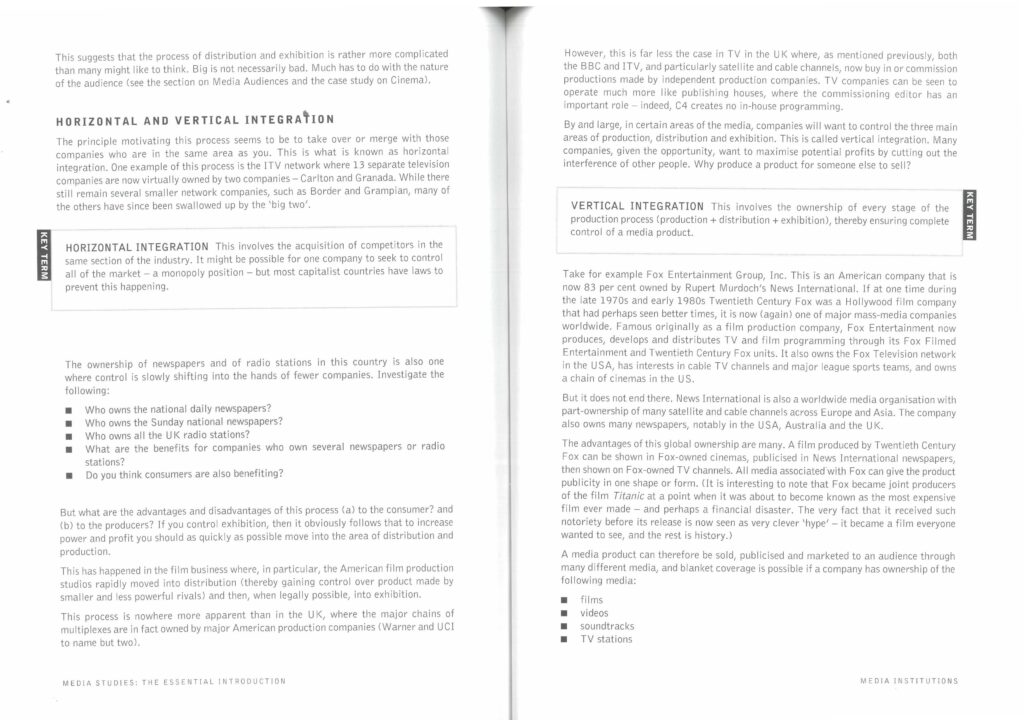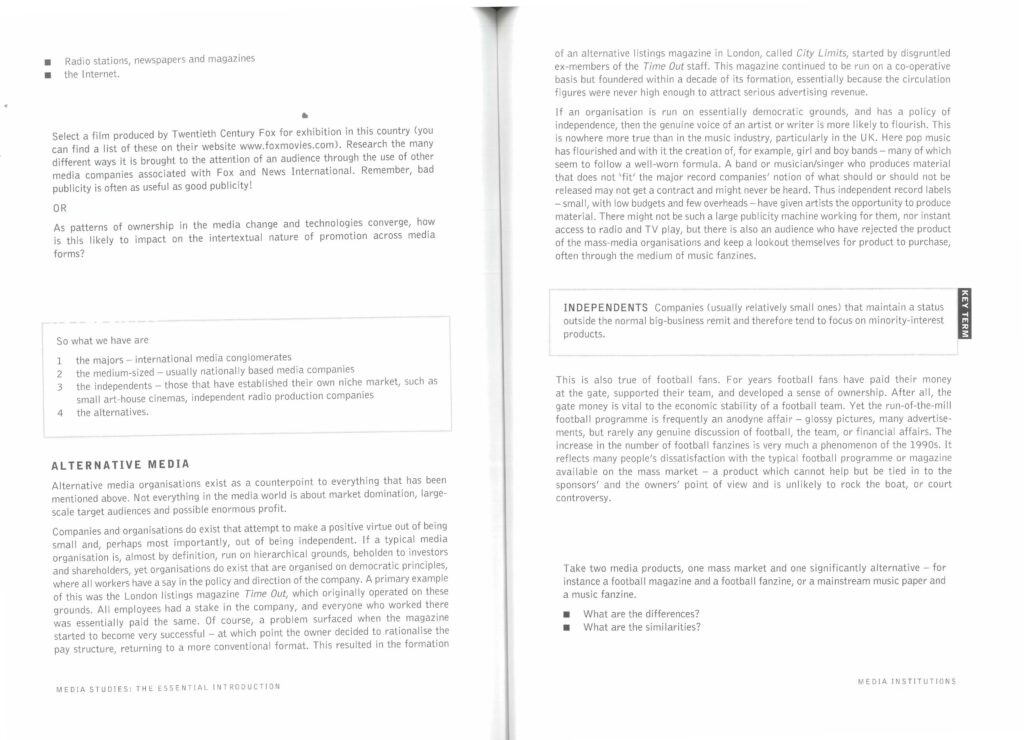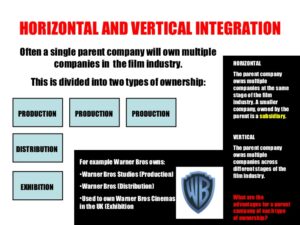David Hesmondhalgh and other critical voices
the distinctive organisational form of the cultural industries has considerable implications for the conditions under which symbolic creativity is carried out’
The Culture Industries (Sage, 2019, p.99)






In this section of your course we are going to study Film and Media Industries, using as a case study the film Blinded by the Light. Important aspects of this study is the production, distribution and exhibition of the film. Do you understand the meaning of the terms?
a) Film production is the process of creating the content of the film
b)distribution is the activities involved in getting the film to the public.
This is normally the task of a professional film distributor, who would determine the marketing and release strategy for the film, the media by which a film is to be exhibited or made available for viewing and other matters.
A film exhibition is a process of showing a movie to the public. The film may be exhibited directly to the public either through a movie theater or television, or personal home viewing (including physical media, video-on-demand, download, television programs through broadcast syndication). For commercial projects, film distribution is usually accompanied by film promotion.
Film distribution consists of working to place a movie in theaters, though it may also be distributed to streaming services. This stage of the filmmaking process includes collaborating with theatres and promoting the movie.
Who owns the guardian?
The guardian is operated by the guardian media group (GMG) which also owns The Observer.
The parent company is Scott Trust limited which was created in 1936 to secure the financial and editorial independence of the guardian, however it was dissolved in 1948 to avoid more death taxes.
The trust was then replaced by the limited company to respond effectively to the rapidly changing media landscape, in 2008. It was drafted to make sure that no one could personally benefit from dividends so that the paper could remain faithful to its liberal roots.
Demographics
2021 data from PAMCo says the guardian had a 3.2m monthly print and an 18.4m monthly digital readership. The guardian also reached an average of 113m unique browsers around the world each month.
Further data shows that more males reading the paper each month, 10.2m males compared to only 9.4m females across numerous platforms. Data also showed that more 35+ people read the paper than under 35.
The data further shows that higher class/more income earning people read the paper compared to others.
The reader
Most guardian readers are often described as left-wing and have a liberal point of view.
The guardian’s target audience is modern and progressive people.
A poll had found that guardian readers hold a progressive view and are motivated by new ideas and innovation, they also have a strong desire to change.
A typical guardian reader is labelled as an activator from SBI’s list of UK consumer groups because they are the most open to new ideas and are at the forefront of innovation.
Guardian Politics
The guardian is part of the quality press, this is a group of national papers which focuses on hard news.
The guardian often promotes the ideologies of the mainstream left of British Politics.
It had declared its support from the liberal democrats in 2010 general election.
The guardian had a liberal perspective which appeals to its progressive consumers.
Newspaper funding
A double page spread in the guardian costs £32.400 and a billboard at the top of the screen or MPU would cost an ad agency around £46.000 a day.
The guardian relies on revenue from its global readership.
Any profit made from their sources of revenue is reinvested in journalism.
The decline in the newspaper industry
In 2012 the guardian lost £100,00 per day, to underwrite the newspapers loses, Scott Trust sold 49.9% of its stake into auto trader to venture capital firm in 2007 and then the remaining 50.1% to the same company in 2014.
They also sold its regional media output to a competitor in 2010 and GMG radio subsidiary in 2012.
In 2020/2021 the GMG increased their revenue by 0.9% to £225.5m.
The total values of the Scott Trust endowment fund and other cash holdings also increased to £1,148.5m from £954m the previous year.
Important Events
In April, a prospectus is issued explaining the aims and objectives of proposed newspaper, the Manchester Guardian. A month later, on 5 May 1821, John Edward Taylor publishes the first Manchester Guardian as a newspaper in the liberal interest. It appears weekly on a Saturday at a price of 7d.
Stamp Duty tax on newspapers is abolished allowing the Guardian to publish daily, Monday to Saturday, at a reduced price of 2d.
On 4 July Guardian Weekly is launched to provide a compact weekly edition of the newspaper, aimed at an international audience.
On 24 August the newspaper changes its title from the Manchester Guardian to the Guardian, to reflect the growing importance of national and international affairs in the newspaper.
The Guardian has a radical redesign, splitting the newspaper into two sections and introducing a new masthead. An international edition is launched in Europe.
The Scott Trust formally sets out its central objective for the first time: “To secure the financial and editorial independence of the Guardian in perpetuity: as a quality national newspaper without party affiliation; remaining faithful to its liberal tradition; as a profit-seeking enterprise managed in an efficient and cost-effective manner.”
G2, the daily features tabloid section, is launched.
The Guardian and Observer contributes editorial content relating to the Edinburgh Fringe Festival to the 1994 FringeWeb. This is thought to be the first online publication of any Guardian journalism.
Thames Valley Newspapers (owners of the Reading Evening Post and the Wokingham and Bracknell Times group of newspapers) is purchased by GMG from the Thomson Corporation.
The group’s radio interests are sold to Emap.
Auto Trader National Magazines is launched as a joint venture.
The Guardian wins widespread acclaim for its coverage of the events of 11 September – it is proclaimed “bold, simple and courageous” at the British Press Awards.
GU’s URL changes from guardianunlimited.co.uk to guardian.co.uk in February. In April its first ever TV advertising campaign is launched
Life, a new Thursday science and technology supplement, is launched, plus a daily media business page.
The Guardian launches its first paid-for website services, including a new digital edition of the newspaper and an advertising-free version of the guardian.co.uk site.
In March, digital editions of the papers launched, allowing access to articles, images and adverts as they appeared in print. In July the Soulmates dating service interactive website goes live. The paper also introduces a weekly tabloid edition aimed at students and distributed throughout UK university campuses.
Reductions in taxes and stamp duty allow the Manchester Guardian to publish twice-weekly; it begins to appear on Wednesdays as well as Saturdays.
On 24 August the newspaper changes its title from the Manchester Guardian to the Guardian, to reflect the growing importance of national and international affairs in the newspaper.
The name of the company is changed to The Guardian and Manchester Evening News Ltd (GMEN).
The Guardian has a radical redesign, splitting the newspaper into two sections and introducing a new masthead. An international edition is launched in Europe.
The Guardian’s investigation into Conservative MP Neil Hamilton wins the Team Reporting Award at the British Press Awards and the Guardian is named Newspaper of the Year by What the Papers Say – an award it also wins in 1998 and 1999.
The Guardian is the first national newspaper to appoint a readers’ editor and publish a daily Corrections and Clarifications column.
The Guardian and Observer election website goes live in February and football.co.uk launches in August.
The newspaper is considered as part of a group called the “quality press”. This is a group of national papers that focus on hard news rather than journalism. Its “analysis” promotes the ideologies of British politics. The paper declared support for the Liberal Democrats in the 2010 election. It then switches back to the Labour Party for the 2015 election.
Reductions in taxes and stamp duty allow the Manchester Guardian to publish twice-weekly; it begins to appear on Wednesdays as well as Saturdays.
On 24 August the newspaper changes its title from the Manchester Guardian to the Guardian, to reflect the growing importance of national and international affairs in the newspaper.
The name of the company is changed to The Guardian and Manchester Evening News Ltd (GMEN).
The Guardian has a radical redesign, splitting the newspaper into two sections and introducing a new masthead. An international edition is launched in Europe.
The Guardian’s investigation into Conservative MP Neil Hamilton wins the Team Reporting Award at the British Press Awards and the Guardian is named Newspaper of the Year by What the Papers Say – an award it also wins in 1998 and 1999.
The Guardian is the first national newspaper to appoint a readers’ editor and publish a daily Corrections and Clarifications column.
The Guardian and Observer election website goes live in February and football.co.uk launches in August.
The newspaper is considered as part of a group called the “quality press”. This is a group of national papers that focus on hard news rather than journalism. Its “analysis” promotes the ideologies of British politics. The paper declared support for the Liberal Democrats in the 2010 election. It then switches back to the Labour Party for the 2015 election.
Liberal theory of the press
This theory basically states that the press should have a freedom of speech and be able to scrutinize the government.
This is because they would not be funded by the government or any other large industries, allowing them not to be held by bias opinions.
This type of press is regulated on a consumer basis, meaning they will take in opinions from the public, and change accordingly. They also act as a mouthpiece for the public too, with the public tribune, taking in public opinions about people in power, and stating those in their newspapers. This also means they’re not regulated by the government and have more freedom to speak about them.
Watchdogs
Watchdogs are a function within the media that protect the public from power. This is done by journalists who speak up about wrongdoings done by the government and other power figures without being restricted on what they’re allowed to say.
examples:

Consumer based approach:
Citizen based approach:

The Guardian watchdog article example:

The Daily Mail watchdog article example:

This theory assumes that the audience chooses what it wants to watch for 5 different reasons.
Understanding why people use certain types of media and what needs do they use, and what gratifications they get from using them.
The strengths of the uses and gratifications theory include its focus on individual motivations and its ability to explain media consumption. Weaknesses include its reliance on self-report data and its limited ability to predict behaviour.